Tet
'68: Task Force Miracle-- the Battle for Lo Giang and CAP Echo 4
Background Information.
In January 1968, the U.S. Military Assistance Command, Vietnam (USMACV)
totaled
nearly 500,000 and had taken over much of the large scale unit warfare
from the South
Vietnamese. III MAF controlled allied military forces in the
I Corps area of northern South
Vietnam. The US 1st Marine Division and 51st ARVN Regiment provided
protection for
the Da Nang area. Enemy forces in the northern I Corps area were
controlled directly by
the North Vietnamese.
III MAF, the US Marine command in I Corps, emphasized the small unit
war in the villages.
Consequently they developed the Combined Action Program (CAP) that
assigned a squad
of US Marines to a village Vietnamese Popular Forces platoon.
One of these units, CAP
Echo 4, was located in the village of Lo Giang (1) several miles south
of Da Nang.
The objective of these and similar units was to create a bond with
the local village
population that would sever their relationship with the guerrillas
and VC infrastructure.
While the Marines emphasized these small unit relations, the MACV forces
were directed
at defeating the enemy's main forces. The battle for Lo Giang
conducted by the US Army
soldiers from the 1st Battalion 6th Infantry and the attempted relief
and eventual extraction
of the Marines at CAP Echo 4 demonstrated the relationship between
these two very
different approaches to the war.
The 1968 TET Offensive begins.
On 27 Jan 68, the Communists announced their seven day cease fire for
Tet 1968. Several
days later, however, they launched the largest offensive of the war.
Attacks began in the
Da Nang area on 30 Jan 68. At 0230 sappers attacked the III MAF
compound in Da Nang.
About one hour later, enemy forces attacked the I Corps headquarters
complex in Hoa Vang.
The following extract from the official US Marine Corps history shows
the following:
"Under cover of darkness, elements of the VC R-20th and V-25th Battalions
had crossed the
Cau Do River. With covering fire provided by 81mm and 82mm mortars,
about a reinforced
company reached the I Corps headquarters compound actually located
within the city of Da
Nang just outside the northern perimeter of the main air base. The
fighting within the compound
continued until daylight. After their breaching of the outer defenses,
the enemy squad fired B-40
rockets at the headquarters building, but then fought a delaying action,
waiting for reinforcements.
These reinforcements never came. The bulk of the enemy attack force
remained in Hoa Vang
Village bogged down in a firefight with local PF and Regional Force
troops reinforced by a
Combined Action platoon, E-3."
"At Da Nang, on the 30th, the fighting did not subside with the coming
of daylight. Elements of
the VC R-20th and local force units which participated in the attack
on Hoa Vang and I Corps
headquarters attempted to escape the dragnet of Marine and ARVN forces.
While the 1st MP
Battalion supported by the 1st Tank Battalion established blocking
positions north of the Cau
Do River, the ARVN 3d Battalion, 51st Regiment swept the sector south
of the river. Caught
east of the Cam La Bridge and Route l, on a small island formed by
the convergence of the Cau
Do, a small tributary of the river, and the Vien Dien River, the VC
turned to fight. A Combined
Action platoon at 0830 saw a number of VC attempting to swim across
the Cau Do to the island."
In the fighting that followed, the 3rd Battalion, 5th Marines and ARVN
force managed to kill
102 NVA and VC by use of artillery and tactical air strikes in the
vicinity of Lo Giang (2) on
30 Jan 68. Many of the enemy were killed as they attempted to
cross the Cau Do River.
[Details about the attacks of Da Nang and Hoa Vang are found at this
link.]
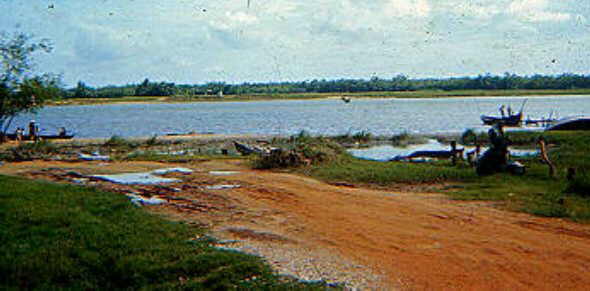
[Looking south at the ferry crossing vic BT 033733 on the Cau Do River
east of Hoa Vang,
approximately 2 km. southeast of the Da Nang airfield. This 1968
photo was taken by Mike
"Tiny" Readinger (CAP Echo 2 and HQ) several months before the TET
offensive and is almost
a shot of the exact path taken by the NVA. The village of Lo
Giang and CAP Echo 4 were located
about 2 km south of the river.]
On 31 Jan 68, Communist forces launched major attacks in 39 province
capitals throughout
the country, and in Saigon and Hue. On the night of 2-3 Feb 68
28 122mm rockets fell on
Da Nang. Elsewhere in I Corps, ground attacks on the Marine garrison
at Khe Sanh
began on 5 Feb 68. On 7 Feb 68, the daring and successful attack
by NVA forces at the
Lang Vei Special Forces camp west of Khe Sanh captured world wide media
attention.
That attack featured the use of NVA PT 76 light armored tanks.
The Marines at Khe Sanh
refused to come to the aid of US Special Forces soldiers who were being
overrun by the
enemy armor.
On 7 Feb 68, the MACV commander, General Westmoreland, called for a
meeting with
the III MAF commander, General Cushman. Concerned that III MAF
had not reacted
properly to the Lang Vei episode and that inadequate precautions had
been taken to
defend Da Nang, General Westmoreland ordered the Americal Division
to supply several
infantry battalions to bolster the defenses south of Da Nang.
III MAF planners decided to
utilize a two battalion Army task force in the northern sector of 3rd
Battalion, 5th Marines
near highway QL1 just south of the Cau Do River. Task Force Miracle,
as the force came
to be named, was formed by the 1st Bn 6th Inf (198th Lt Inf Bde) and
2nd Bn 1st Inf (196th
Lt Inf Bde) from the Americal Division.]
The 1st Battalion 6th Infantry, 198th Light Infantry Brigade, Americal
Division moves north.
At 1515 hours on 7 Feb 68, the 1st Bn 6th Inf was ordered to provide
two
infantry companies and a command element as soon as possible
to III MAF in Da Nang.
Alpha Company, 1st Bn, 6th Inf (A/1-6) previously had been designated
as the "sixty minute
alert company," tasked with reinforcing units elsewhere in Vietnam.
By 1630 hours they were
at LZ Gator south of Chu Lai and ready to move to Da Nang. At
1735 the 131 men of
Alpha company under the command of CPT Francis X. Brennan arrived at
LZ 410, located
at AT 991678. They were greeted by the commander of the marine
unit at that location who
was under the operational control of the 1st Marine Division.
The move had happened so
rapidly that "their presence left [the commander and staff of
LZ 410] at a loss." Only
sketchy information about enemy activity was available. The 1st
Bn 6th Inf commander,
LTC William J. Baxley Jr. evaluated the situation and ordered his two
available infantry
companies to move into locations just south of the Cau Do River.
A/1-6 received their orders and moved out at 2200 hours. By 080155
Feb 68 they had arrived at
their night defensive position (NDP) BT 022714 approximately 400 m.
east of the Cam
Le Bridge.
The 128 men of Co. C. 1st Bn 6th Inf (C/1-6) under CPT Max D. Bradley
were only a hours
behind, and closed on their NDP at BT 005694 by 080215 Feb 68.
The plan was for both
companies to move from their NDPs to the small bridge at BT 025719
and then to conduct search
and destroy missions on the island formed by the Cau Do, a tributary
of the river, and the Vien Dien
River with center of mass for the operations at BT 035725.
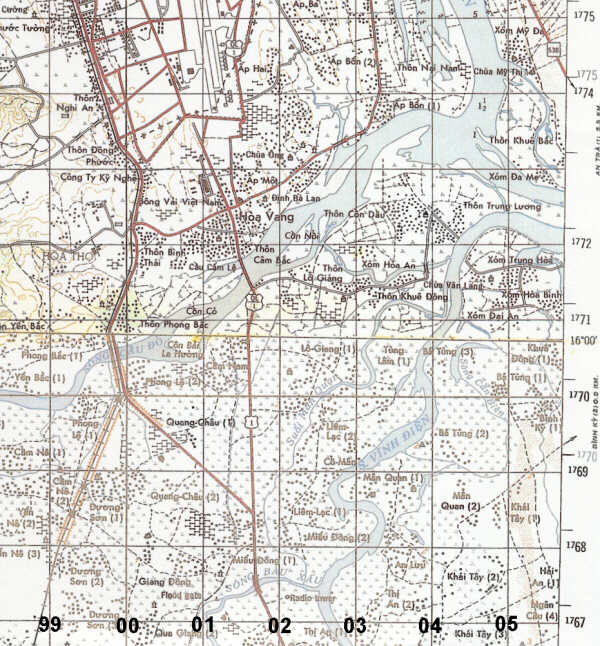
Extract of map from the US Army After Action Report provided by Tom
Hall (1/6 Inf 1967-68)
Map sheets 6641-3 (Da Nang) and 6640-4 (Dai Loc) meet between the 70
and 71 gird lines.
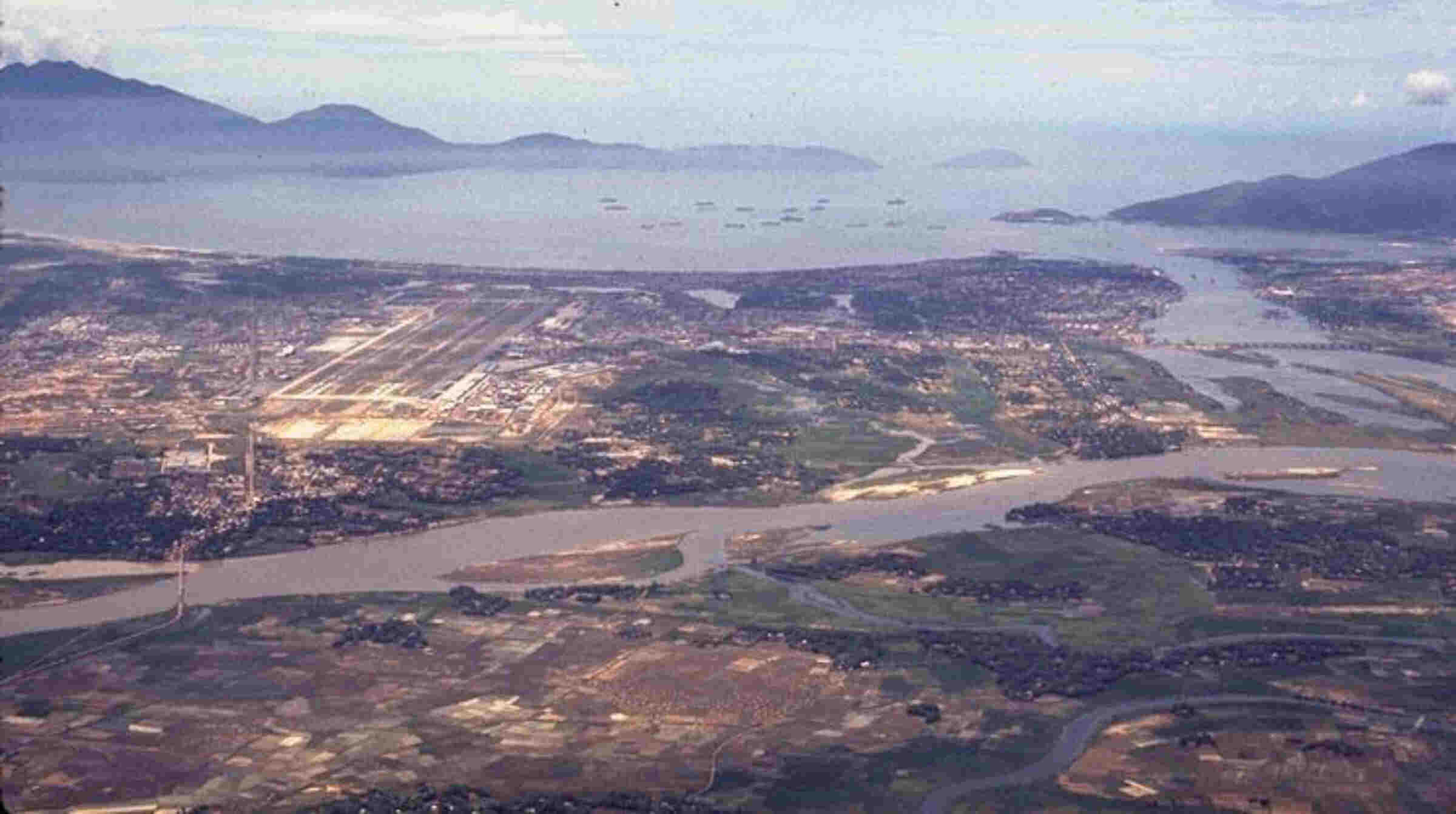
View of the Da Nang airfield and base complex looking northward across
the Cau Do River.
Highway QL1 is visible as it approaches the Cam Le Bridge at the left
of the photo. The island
in the Cau Do River near the center of the photo provided a fording
site for the VC during their
attack on 30 Jan 68. The tree line just visible along the extreme
bottom edge of the photo directly
below the Cam Le Bridge concealed more than 1,000 NVA troops that were
only 3,000 m. from
the end of the airfield at Da Nang. On 8 Feb 68, the soldiers
from A/1-6 Inf moved southward
across the rice paddy area toward the enemy concealed in the tree line.
This photo, taken from
about 4,000 ft almost directly above Lo Giang, was provided by Mike
Readinger
The Battle for Lo Giang and CAP Echo 4.
Enemy activity began anew early the morning of 8 Feb 68. At 0345
hours, enemy mortar
rounds fell into the CAP Echo 4 compound vic BT 028704 near Lo Giang.
By daylight, enemy
ground forces surrounded the CAP hamlet. At 0602 hours, the fourteen
men at the location
under the command of SGT B. Keith Cossey received heavy small arms
fire from BT 027699.
Four NVA killed in the action were found to be armed with CS grenades.
All friendly units
in the area were alerted of the enemy gas attack capabilities.
The defenders at CAP Echo 4
had expended most of their ammunition, but rearmed themselves with
enemy weapons and
ammunition.
As daylight arrive over the area, a OV-1 "bird dog" aircraft detected
approximately 400
persons on the ground in the vicinity of Lo Giang. The
aerial observer could not determine
whether the soldiers were enemy or friendly before they disappeared
under the canopy of trees
in the area.. Such brazen daylight moves by large enemy forces
were a rarity. The information
about the large number of suspected enemy soldiers was not communicated
to the 1st Bn 6th
Inf soldiers in the vicinity of Lo Giang.
At first light, the local "coke kids" found the soldiers of C/1-6 near
BT 005 694 and began
trying to sell soft drinks. One of them not only recognized the
198th Inf Bde shoulder patch,
but said "198th, you come fast." In view of the attack on the
Marines at CAP Echo 4, C/1-6
was ordered to move from its NDP location and to advance to the northeast
toward the
Lo Giang village at BT 025705.
Because of the size of the attack against CAP Echo 4, Marines from adjacent
CAP units and
the CAP headquarters north of the Cao Do formed a reaction force under
CPT Howard L.
Joselane to come to their aid. One of the Marine volunteers in
the force, SGT Dennis W.
Hammond, had less than three weeks to go before returning to the States,
but stated that this
was his "last chance" to accomplish something. The relief force
was taken by truck across the
Cam Le Bridge and south on QL1 to the vic BT 016698 where they started
toward Echo 4.
At 0826 hours, A/1-6 received small arms fire from BT 026705.
They also observed large
numbers of civilians fleeing to the northeast from Lo Giang village.
Having received the proper
clearance, they began firing 81mm mortar rounds into the outskirts
of the village. As C/1-6
began to crossed highway QL1 near BT 016698 at 0940 hours, automatic
weapons from
enemy soldiers located in the pagoda at BT 022724 passed over their
heads and increased
as they advanced. The enemy fire, however, may have directed
at the Marine relief force who
was much closer to the village.
As the CAP relief force under CPT Joselane that had been attempting
to reinforce CAP Echo 4
approached the tree line on the west end of Lo Giang, they suddenly
came under intense fire
at close range. They sought shelter in a drainage ditch just
outside the tree line. Shortly after
the attack began, they were overwhelmed by large numbers of VC and
NVA. They radioed
for help and then a short time later announced that they were being
overrun. Capt Joselane's
last words over the radio were "they're all over us....no way
out. Don't send anyone
else in here...tell my wife I love her." Thirteen marines
in the relief force were killed by
the enemy. Some of the Marines were bayoneted as they lay wounded.
Three Marines, including SGT Hammond, were captured by the NVA as POWs,
but one later
managed to escape. [SGT Hammond later died in captivity.]
One Marine, although badly
wounded, miraculously survived due to the magnanimity of a NVA radio
operator who spared
his life. The Marine had befriended the NVA soldier earlier while
on a CAP mission. The
NVA soldier had pretended to be a Vietnamese peasant who needed
food and medical attention.
.
[Note: The harrowing nature of the ordeal suffered by the Marines
in the relief force and their
incredible bravery has been spelled out in detail in an excellent story
prepared by Mike "Tiny"
Readinger that can be found on the Marine CAP
web site. Those few brave Marines in the
aborted relief effort did not stand a chance against a numerically
superior NVA force that would
practically overrun two platoons of A Co/1-6 Inf only a short time
later. Their efforts, however,
provided hope to the beleaguered CAP defenders and forced the NVA to
shift their attention
away from CAP Echo 4.]
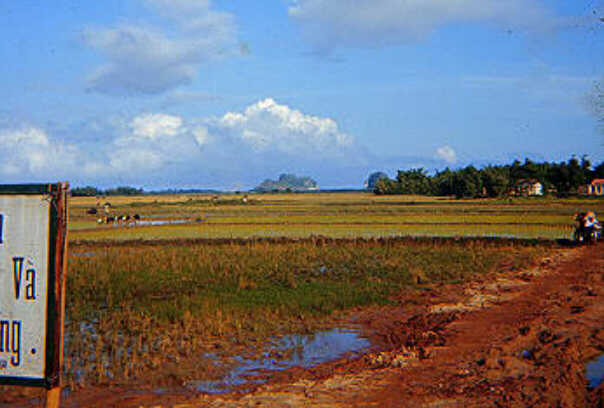
[This photo by Mike "Tiny" Readinger probably was taken in December
1967 at BT 016 706 looking
eastward toward the village of Lo Giang. At the time of
the battle on 8 Feb 68, the rice fields were
about a foot tall. Soldiers from A/1-6 Inf advanced from near
the trees on the left behind the sign and
crossed the rice fields in the distance toward the far side (i.e. north
side) of the tree line visible on the
right side of photo. Enemy mortars near a pagoda just to the
right of this photo shelled them in the
open as the attempted to advance across the fields. Marble Mountain
is in the distance. CAP Echo 4
is located down the path/road about 800m through the village.
The bodies of the valiant Marine relief
force were found to the right of this photo, in a drainage ditch just
short of the tree line. It is believed
that Marine medivac helicopters landed on the path/road to evacuate
the wounded from C/1-6].
In the meantime, CPT Bradley (C/1-6) sent his 2nd platoon forward toward
the village. One squad
was to move into the village to determine where the NVA soldiers were
located. They crossed the
ditch several hundred meters from where the bodies of the Marine relief
force were later found and
noticed a LAW pointed down the ditch as a booby trap. They blew
it in place with grenades. At
about 1015 hours they spotted three NVA soldiers running away into
the village. They wounded
and then caught one who was trying to escape down into a tunnel.
He
was dressed in a khaki
uniform, had been hit in the shoulder and arm, and was pleading for
medical help.
Just as they were attempting to question him, "all hell broke loose"
as the NVA opened fire from 50 m.
or less. Several NVA snipers were cleverly concealed in the tall
trees that were devoid of limbs or
vegetation for the first thirty feet of trunk. The squad
leader was hit immediately, and then the medic
(PFC Walter R. Pratt) was mortally wounded. Four more were wounded
by 1100 hours. The
unit was pinned down in the rice paddy area west of Lo Giang, while
their platoon in the village
was under continuous attack.
Meanwhile, the enemy attack on CAP Echo 4 continued in earnest.
The Marines in the small
fortified position near the village of Lo Giang (1) reported that they
were under heavy attack by
large numbers of NVA soldiers. Although badly outnumbered, the
CAP Echo 4 defenders
were fortified with bunkers and wire entanglements.
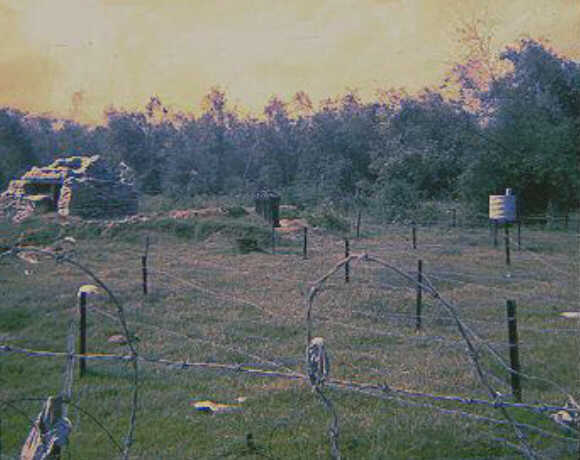
[1968 photo of the southern portion of the perimeter at CAP Echo 4
provided by Mike "Tiny"
Readinger, who was at the CAP Echo headquarters as an RTO during the
battle. His story on
the CAP web site contains
detailed information about the incredible difficulties faces by the CAP
Marines.]
Because of the intense automatic weapons fire and mortar rounds that
inflicted many casualties,
C/1-6 was unable to advance toward Lo Giang. In the meantime,
Company B, 1st Bn 6th Inf,
under the command of CPT Dan A. Prather, had been flown north from
LZ Gator near Chu Lai
and had arrived south of Da Nang at LZ 410 at 1050 hours. At
1132 hours they were ordered
to move by truck to BT 015695 and to link up with the Marines under
attack at CAP Echo 4.
Company G, 2nd Bn 3rd Marines, from LZ 410, was on the right flank of
B/1-6 Inf as
they moved toward CAP Echo 4. The Marines killed 7 NVA as they
advanced. At 081510
Feb however, they were released to their parent unit and moved to the
east of the Vinh Diem
River to search for a reported 1,000 man NVA force. [The next
day Companies G and F
of 2nd Bn 3rd Marines killed 107 NVA at BT 031698].
Approximately 1500 meters to the northeast, the combat action near A/1-6
was increasing.
At 1132 hours, the soldiers began receiving heavy automatic weapons
fire from BT 025706.
A/1-6 reported receiving additional automatic weapons fire at 1136
hours. Their mortar
fire into the village paid off with secondary explosions. At
1233 hours, CPT Brennan
decided to "check out the village" and told his forward observer to
have a fire mission
"laid on the village" as they prepared to attack. In an audio
tape he prepared in Feb 68,
CPT Brennan described the action in his own words:
"I put two of my rifle platoons on a skirmish line, followed by
the CP group
centered on the two platoons and a platoon held in reserve trailing
the CP group
by 100 meters. ...The two platoons on line covered a width of
approximately
200 meters. The configuration was 2nd Platoon on the left
(East) side and
3rd Platoon on the right (West) side and the 1st Platoon trailing
in reserve.
The weapons platoon went into action [from the cover
of the NDP position in the
graveyard at BT 023710]."
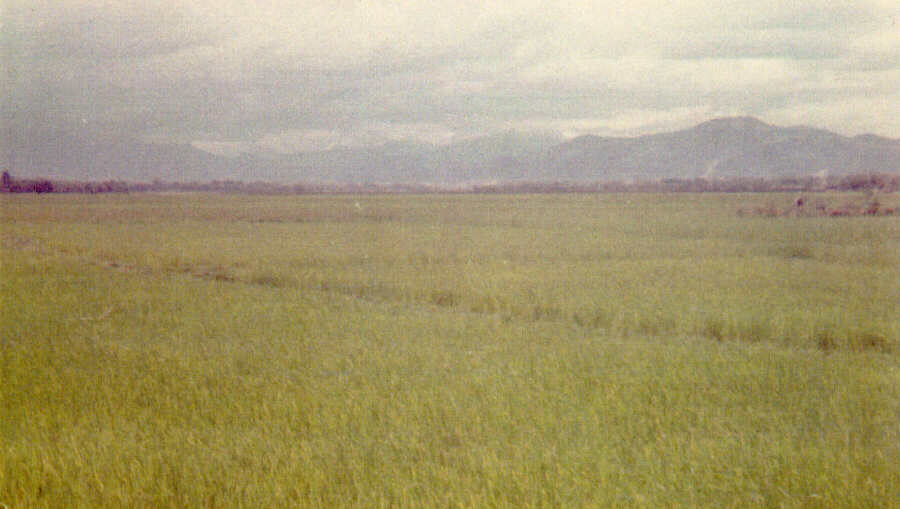
This photograph looking westward shows the terrain between A/1-6 and
the enemy concealed to
their south. The entire area they crossed was flat and was covered
by rice crops over a foot tall. To
their front (i.e. southward) and along a northeast-southwest line running
from BT 029708 to a pagoda at
BT 021704 was a tree line. The northwestern corner of that tree
line is shown at the extreme left
of the above photo provided by Don Kaiser (A/1-6 Inf). [The graveyard
where the mortars deployed
is just to the right of this photo.] It was along this tree line
that the enemy was thought to
be deployed. Unknown to them was an 18" tall rice paddy dike
about 100 meters north of and
paralleling the trees. The enemy soldiers, who had apparently
observed the skirmish line approaching
the woods, low crawled out into the field and hid behind the dike.
The soldiers later stated that
they were "astonished" that the VC were so well concealed by the rice
and small dikes.
As the soldiers of A/1-6 Inf moved southward, they came under
heavy mortar fire about 110 meters
from the trees. At the same time, they came under a tremendous
volume of enemy rocket,
machine gun, RPG, and rifle fire from the dike only ten to twenty meters
away. A furious fight began as
the NVA soldiers charged across the field. The officers and men
of A/1-6 later reported that the
enemy leaders were easily identifiable as they were moving behind groups
of seven to ten men using
hand and arm signals to direct their units. In CPT Brennan's
words:
"A Company was flanked on both sides by at least an NVA company
on each
side and was sustaining a frontal assault by another NVA company.
The
enemy assault element was on line, advancing in a crouched firing
position
from the northwest wood line at the village. The flank
enemy elements were
attempting to link up at our rear, thus encircling [the
unit]."
In a matter of seconds A Co. and two companies of a unit positively
identified as the
60th Main Force Viet Cong Battalion (60% to 70% NVA soldiers), First
NVA Regiment
2nd NVA Division with the 370th Hqs Company, were in a hand to hand
battle in the
rice paddies immediately north of Lo Giang (1). During the initial
heavy contact, A Co.
killed 78 NVA soldiers and suffered 10 KHA and 22 WHA.
The second platoon leader, 2LT Bowman, was killed in the fight, but
subsequently received
the nation's second highest decoration for valor--the Distinguished
Service Cross. At one
point, CPT Brennan received a call from the second platoon radio telephone
operator
(RTO) who thought 2LT Bowman was dead:
"The second platoon RTO called in a state of near panic.
He said the enemy
were crawling directly to his rear and each flank."
CPT Brennan observed that "The proximity of the enemy fire was
approximately
ten to twenty meters at times. The enemy was attempting
to intermingle with
my troops having cut off our route of withdrawal." He
concluded that the
"only hope left for the company was to pull back to the mortar
position and
to reorganize."

This photo of the cemetery at BT 026 710 (400 m.directly north of the
tree line at Lo Giang) was
taken by Alan Allen (A/1-6) on the day of the battle. Photo is
looking westward past the clump
of trees toward Cam Le Bridge and Freedom Hill in the background.
The A/1-6 mortars were
located near this position and fired to support the assault on the
tree line to the south.
At 1415 hours, on the west side of Lo Giang, the platoon from C/1-6
inside the village popped
smoke on both sides of their position.. Eight sorties of tactical
air support arrived from the 1st
Marine Air Wing. The bombs and other mixed ordnance blunted the
continuing NVA attack.
The men from C/1-6 in the western part of the village dragged their
dead and wounded out and
low crawled back across the paddies toward the highway. At some
point, Marine medivac
helicopters were able to land on a large dike that ran perpendicular
to the road and toward the
village. All six soldiers were dusted off by Marine helicopters,
and the accompanying gun ships
remained to provided additional fire support.
After the air strikes, the NVA resumed their assault from the northern
side of Lo Giang, but the
defenses of A/1-6 held. Seventy four additional NVA were killed
in the open. At 1500 hours,
CPT Brennan was wounded, along with his two RTOs. Both radios
were destroyed and
communications were lost with the battalion headquarters. PFC
Victor Girling, an artillery
reconnaissance sergeant, bandaged one of the RTOs and dragged him in
a low crawl 300 m.
back to the graveyard.
Not all the combat action had been confined to A/1-6. C/1-6 continued
to be subjected to
rifle fire and heavy automatic weapons fire. As CPT Bradley (C/1-6)
assembled his
platoon leaders to plan their next move, the unit came under
a severe mortar barrage and all
the officers were wounded. At 1530 hours were subjected to an
intense mortar attack at
BT 018698. By late afternoon they had suffered 2 KIA and 28 WHA
(including all officers)
as they tried to move toward Lo Giang. Abandoning their rucksacks
and packs, the soldiers
moved out of the area and to the west of the highway away from the
precise targeting
of the enemy mortars.
Company B, 1st Bn 6th Inf also ran into significant enemy resistance
on the southwest side
of Lo Giang. At 1450 hours as they tried to move through
the village and toward the CAP
Echo 4 location, they came under small arms fire at BT 022694.
At 1532 hours they
were subjected to a heavy enemy mortar barrage. In regard to the enemy
mortar fire,
CPT Prather's said:
"[t]he simple fact that we were operating in a wet rice paddy
saved a lot of lives.
Rounds buried themselves before detonating....[The mortar rounds]
hit right
behind us within 5 to 10 feet, but they went down in the mud
so far that all it
did was spray our entire backs with mud and absolutely no shrapnel."
By 1615 hours they finally located the enemy mortar position, and pounded
it with their
own mortars. The soldiers hugged the dikes very closely and were
able to crawl into good
fighting positions. The enemy soldiers got up out of their fighting
positions and formed on
line to assault the Americans. As CPT Prather related:
"That became the downfall of the main [enemy] force in doing that,
in that we
were hidden pretty well behind the dikes. We just cut them
apart....I thought it
strange looking up and seeing these people coming and thinking,
my God, they're
on line for an assault."
Eventually the Americans counter-attacked and overran the enemy mortar
position at
BT 023697. They killed 30 NVA at a loss of only 2 soldiers WHA.
Fortunately, the Marines at CAP Echo 4 did not have to wait on the arrival
of B/1-6 Inf.
According to the official Marine historical accounts, they had managed
"to hold out against
overwhelming odds." At 1550 hours they were extracted by air.
At 1615 hours, PFC Girling reestablished radio contact for A/1-6, and
gave the battalion
headquarters the first word of the company's situation. While
he coordinated artillery and
gunship strikes, the soldiers had consolidated their position in the
cover of the cemetery at
BT 022713. Up to that point, fourteen were known to have been
killed, and another 35
wounded. CPT Brennan was evacuated by helicopter, and 2LT William
B. Wendover
assumed command of the unit.
Because of the losses and reduced strength of A/1-6, Co E, 1st Bn 6th
Inf (E/1-6) was
ordered to move from LZ 410 to help consolidate their defenses with
A/1-6 Inf at
BT 022712. Co C/1-6 also moved into their position at BT 014697.
The confirmed enemy
body count at that time was as follows: A - 207; B - 37; C-14;
G (Marines)- 8. Ninety
percent of the enemy had full web gear, including combat packs.
Several had been armed
with CS or WP grenades that exploded in a cloud when they were struck
by buckshot or
bullets. Over 100 enemy weapons were counted by A Co alone.
It should be noted that until 081430 Feb 68, the 1st Bn 6th Inf commander
did not have a command
and control (C&C) helicopter at his disposal. When it finally
arrived it was used for two hours for
medivac and resupply. A/1-6 had 28 WIA and C/1-6 had 17 WIA.
The C&C helicopter pilots
were WO1 Edward A. Fitzsimmons and 1LT David R. Ewing of the "Minutemen",
176th Assault
Helicopter Company. They flew 21 sorties into the battlefield,
evacuated 31 wounded, and
resupplied all companies. To quote the official After Action
Report:
"[w]ithout the courage and skill of Mr. Fitzsimmons and LT Ewing
it is doubtful if all
the wounded would have been evacuated prior to darkness on the
night of 8 Feb 1968."
The aftermath.
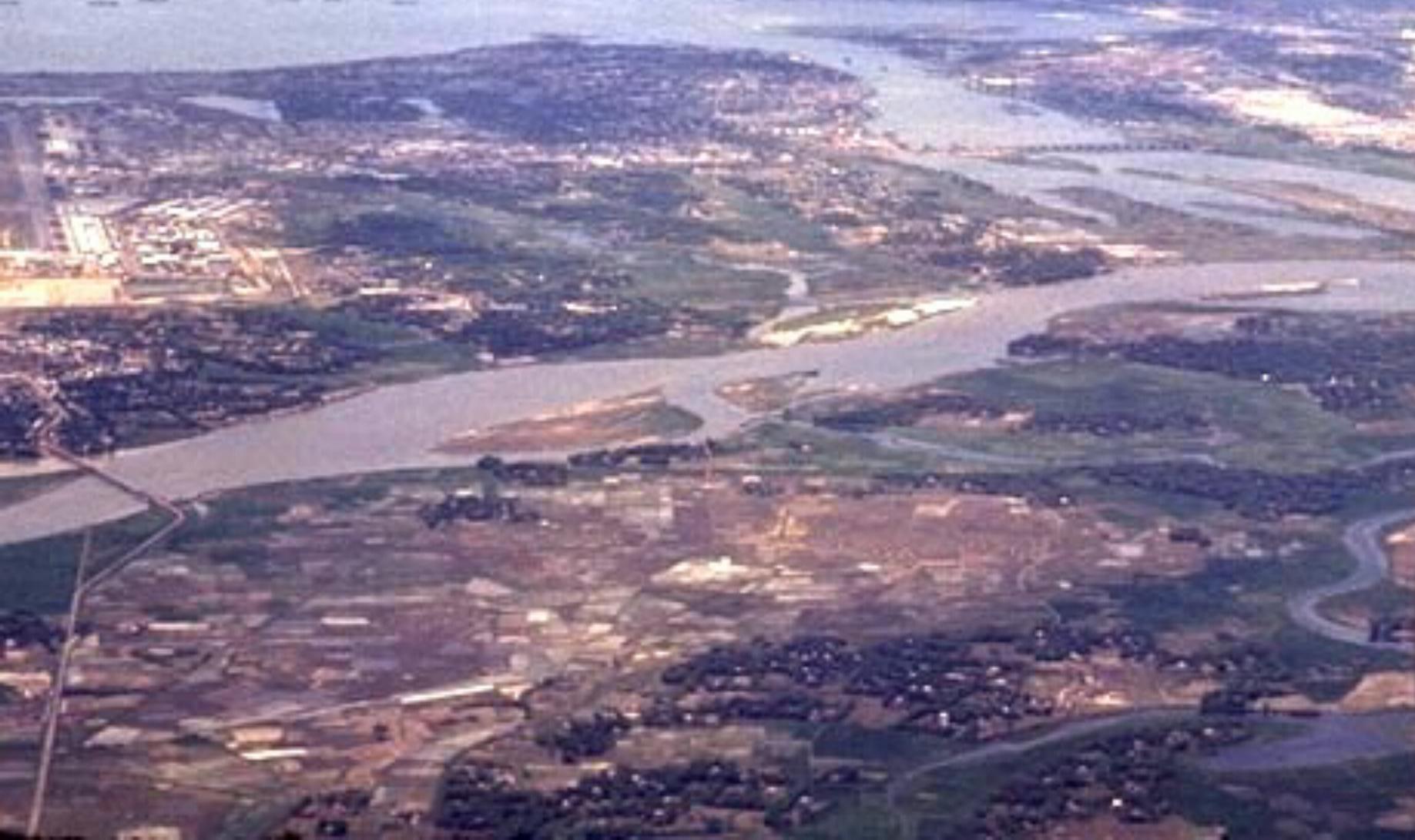
From 082011 to 090705 Feb 68, all elements of 1st Bn 6th Inf reported
no nighttime enemy activity
on the battlefield. Unfortunately this was not true for the lone
remaining survivor of the CAP 4 relief
force. He was searched and kicked several times while he played
dead from his multiple wounds.
He was discovered alive the next morning by Marines from the CAPs near
Hoa Vang.
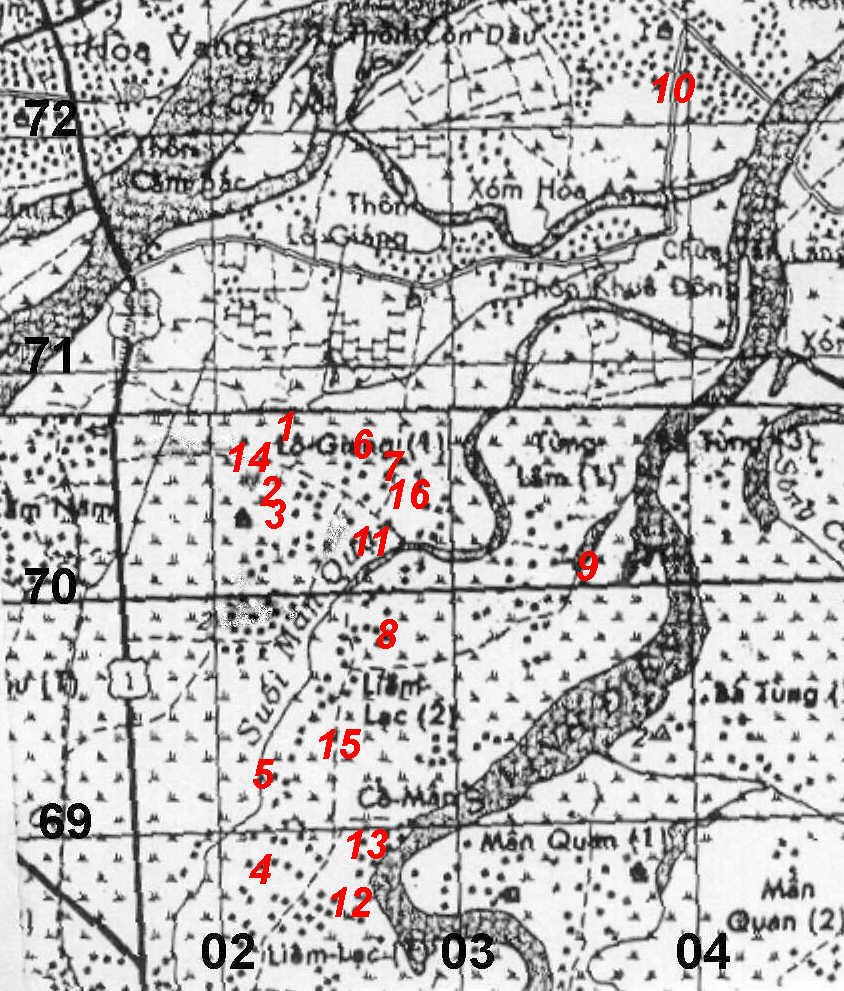
[Red numbers show approximate locations where NVA equipment, supplies,
and bodies were found.]
The next morning Co A and E began conducting a sweep of the Lo Giang
area. While moving through
the battlefield Co E/1-6 Inf continually reported evidence of blood
trails and paths through the rice
where the NVA dragged away their dead and wounded.1
Near a pagoda at BT 022704 Co A/1-6
fount 43 NVA bodies with web gear and packs that had not previously
been counted.2 At the same
location they found 52 Chicom grenades, 1500 rounds of ammunition,
and the two damaged PRC-25
radios that had captured from A/1-6 the previous day. Co A/1-6 had
pounded the area near the
pagoda with mortar and automatic weapons fire the previous afternoon.

1968 photo of the path leading through Lo Giang to CAP Echo 4 provided
by Mike "Tiny" Readinger
(CAP Echo 1968) [readincm@earthlink.net] The dense vegetation
in and around Lo Giang and
CAP Echo 4 provided ample concealment for the NVA as shown in the photo
above. Search and
destroy sweeps by 1-6 Inf troops after the battle revealed that large
numbers of NVA troops had
occupied practically every portion of the cover.
At 0930 hours C/1-6 Inf found three LAWs, one M60 MG and a box of documents
at BT 022688.4
At the same time, B/1-6 found a missing soldier from C Co and the remains
of another MIA.5 One
or more of the dead Americans were found with
their hand tied behind them, shot in the head.
At BT 025706 Company A and E/1-6 found two large piles of mixed NVA
and American equipment.
The piles were approximately four feet high and twelve feet in diameter.6
Most of the equipment was
NVA. At 1210 hours, C/1-6 Inf found the bodies of seven
NVA soldiers with web gear and green
uniforms from the 370th Hqs Co of the 1st NVA Regiment. At 1025 E/1-6
reported from Lo Giang
that they found the remains of four soldiers from A/1-6 who had been
reported as MIA the previous
day.7 At 1230 hours, B/1-6 found the bodies
of four NVA soldiers from the 60th Bn, 1st NVA
Regiment, 2nd NVA Division at BT 027699.8
At 1435 E/1-6 located 1 M-1 rifle, two M-1 carbines,
one RPG MG, 50 Chicom grenades, several sets of NVA web gear, and one
NVA gas mask at
BT 025705. It was obvious that the enemy had been soundly defeated
as it was unlike the NVA
or VC to abandon bodies, weapons, and equipment on the battlefield.
The 1st Bn 6th Inf units continued to search the battlefield for signs
of the enemy on 10 and 11 Feb 68.
At 100828 Feb 68, Co C/1-6 found eight NVA bodies soldiers with an
AK47 rifle at BT 030706.9
One of the bodies, thought to be Chinese, was
determined by MI personnel and a medical team
to be ethnic Noung. Cos E and A/1-6 moved
into the Then Khue village area after CH47 aircraft
came under fire from that area. They found
two LAWs (light antitank weapons), one expended, at
BT 035716. 10
Co
C/1-6 found nine additional NVA bodies in brown uniforms with web gear
and
AK47 magazines in the vicinity of BT 026703.11
By
the evening of 10 Feb 68, it was evident that
the TF Miracle area of operations was cleared of NVA and Main Force
VC forces. Nevertheless,
significant discoveries of weapons and ammunition continued.
At 111100 Feb 68, C/1-6 found four prepared mortar position and four
82mm mortar
rounds in the hamlet of Co Man at BT 025687 that had been used to mortar
A Co during the battle
for Lo Giang.12
Thirty minutes later they found a 4'x4' box of green uniforms, a brief
case full of
documents, and a trench system with fire lanes and fighting positions.13
E/1-6 found two RPG MG,
flares, 24 Chicom grenades, NVA pistol belts, canteens and a gas mask
near BT 022709.14 At
BT 025694 C/1-6 found 29 Chicom grenades, 8 RPG rockets with boosters,
1 AK47 rifle with
4 magazines, and one Winchester 12 ga. shotgun.15
At 111145 Feb 68, A/1-6 found a hugh
amount of ammunition on the eastern side of the Lo Giang hamlet.16
This included 240 60mm mortar
rounds, 48 M-26 grenades, 576 12 ga. shotgun shells, 50 claymore mines,
3,500 round of .45 cal.
ammo, 847 cal 30 round, 2,000 rounds of AK47 ammo and 200 Chicom grenades.
Although vast quantities of enemy weapons, ammunition and equipment
were discovered in the days
after the battle for Lo Giang, saturation patrolling located few live
enemy soldiers. Ninety enemy
bodies were found at BT 044704 by Marine patrols. The absence
of any signs of fighting at the
location indicated that the 60th Main Force VC Battalion had retreated
to the east with their dead
and wounded.
On 12 Feb 16, the 1st Bn 6th Inf had completed its mission as part of
Task Force Miracle in the
defense of Da Nang. That effort had been costly, as the 1st Bn
6th Inf lost 22 soldiers killed and 68
wounded in action. The Marine relief force lost 12 killed, three
captured as POWs [one later
escaped while the other 2 died in captivity], 1 wounded, and only 1
escaped back to CAP Echo 2.
[Note: as a historical comparison, the loss of 34 KIA in only a few
hours by a battalion sized unit is
a tragedy comparable to the 36 KIA suffered by the 3rd Bn 187th Inf,
101st Abn Div, in ten days
of combat at the infamous battle for "Hamburger Hill" (Dong Ap Bia)
during 10-20 May 1969.
Other Army and Marine units also suffered greatly during the Vietnam
war, but the ferocity at
Lo Giang was seldom matched.]
At the end of the mission, the 1st Bn 6th Inf was extracted from the
area and moved south to LZ Baldy,
where they were place under the operational control of the 3rd Bde,
4th Infantry Division to participate
in Operation Wheeler/Wallowa.
------------------------------------------------------------------------------------------
Additional information will be added to this account of the battle as
it becomes available. To
contribute additional information to this story, or to make comments,
corrections, etc. please
contact wr9r@aol.com.
Note: A memorial service was conducted in Vietnam by the 198th
Infantry Brigade on 21 Sep 68
to honor those soldiers who had been killed during the first year the
unit served in Vietnam. Soldiers
from the 1st Bn 6th Inf who were killed at Lo Giang were honored at
that time. They include:
2LT Joseph B. Bowman
SGT Robert N. Carter
SP4 James S. Cerione
SP4 Ralph A. Dahm
PFC Amos H. Boutwell
PFC Robert L. Dykes, Jr.
PFC John I. Haselbauer
PFC Brian F. Durr |
PSG John R. Poso
SGT David L. McKinney
SP4 Denton A. Carrasquillo
SP4 George R. Denslow
SP4 Lanny E. Hale
SP4 Rodney P. Troyer
SP4 John L. Jervis III
PFC Walter R. Pratt |
SSG Ramon H. Gonzales
SP4 James L. Lopp
SP4 James E. Parker
SP4 John A. Wilcox
SP4 Michael Pumillo*
PFC Franklin Clovis
PFC Charles E. Hodge |
SP4 Pumillo was killed later in the day, after dark.
----------------------------------------------------------------------------------------------
The account of the battle was prepared by Wayne R. Johnston based
on the following
information: the 1st Bn 6th Inf Combat Action Report (Battle
for Lo Giang) dated 23
February 1968 found at the USAIS Library, Ft. Benning GA; oral accounts
by several
survivors of the battle; an audio tape made in February 1968 by CPT
Francis X.
Brennan while he was recuperating from wounds; a US Army Military History
Institute
oral history report from LTC (then CPT) Dan Prather dated 1984; Mike
Readinger's story
about CAP Echo 4; the USMC publication US Marines in Vietnam, the Defining
Year 1968;
several newspaper articles from the Americal Division newspaper, and
a special report to
The Armored Sentinel (Fort Hood, TX) provided by Tom Hall (1-6
Inf 1967 -68); and,
the 198th Inf Bde Memorial Ceremony program (provided by Alan Allen,
A/1-6 1967-68).
[This account of the battle: Copyright 2002].
Choose historical selections from the index at left or link to the 1st
Bn 6th Inf Home Page